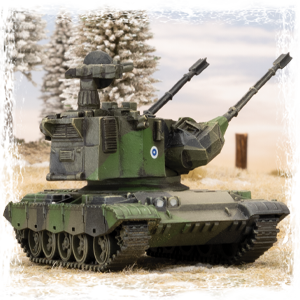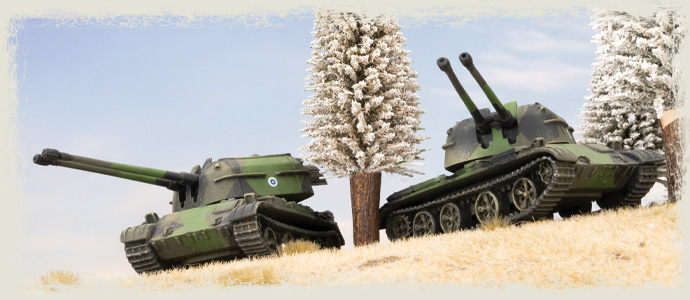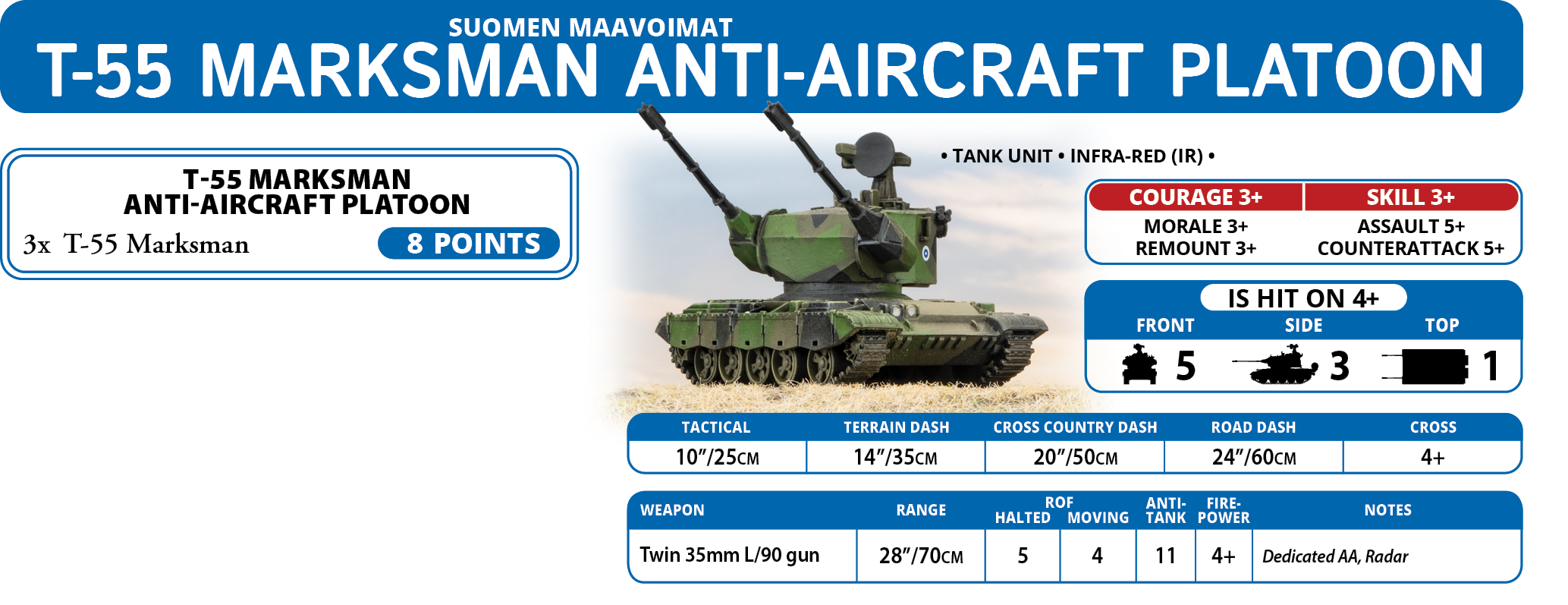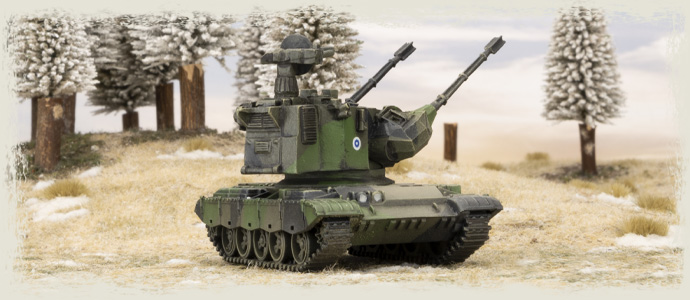|
|
 |
|
|
T-55 Marksman: the synthesis of capitalism and socialism
 |
T-55 Marksman: the synthesis of capitalism and socialism
By Livio Tonazzo
The new Nordic Forces is a particularly interesting book. In fact, it includes the rules for bringing the Scandinavian nations to the tables of WW3: Team Yankee. All in all, these are little-known armies, with unique and particular equipment ... for this very reason, they are so fascinating! Everyone knows the Abrams and the Leopard 2, maybe someone knows the Chieftain but who has ever heard of the STRV-103 S Tank? The Finnish army, unlike the Swedish one, could not rely on its own industry to develop domestic equipment and you must therefore turn to foreign markets.
|
|
The choice, also for reasons of political expediency, fell on the Soviet one both for MBTs and for lighter vehicles. This may make you smile if you consider the ancestral rivalry between the Finns and the Soviets, but it can also be said that since the Second World War, the Finns were used to using Soviet tanks, such as the T-26, the T-28, the KV and BA-10. Nothing new on the northern front!
|
|
As for self-propelled anti-aircraft defence, the Finnish Army purchased twelve ZSU-57-2s between 1960 and 1961. They were designated as ItPsv SU 57-2. While effective for the years in which they were purchased, the ZSU-57-2s were obsolete in the second half of the 1980s. They lack tracking and targeting radars, so have only limited utility against fast-moving attack aircraft, but can be used to defeat enemy helicopters and provide additional ground support fire. The need to guarantee better anti-aircraft protection prompted the Finnish military leaders to look for a more modern solution.
|
|

|
|
The choice fell on the Marksman turret, developed in the UK by the Marconi Company. It is, without too much surprise, the same weapon system that equips the Chieftain Marksman but also the Gepard. The peculiarity was the hull on which it was installed. In order to optimize logistics and spare parts, the T-55 was chosen, which was available in discrete quantities and at an affordable cost. In fact, at the end of the 1980s, the T-55 was a rather obsolete tank and despite the updates it could only be destined for secondary roles. The reuse of the hull to make a self-propelled anti-aircraft gun was perfectly logical and somewhat reminiscent of what was done by almost all armies during the Second World War. Thus was born the T-55 Marksman, which is certainly one of the most particular means of this book Nordic Forces. Particularly because it is a vehicle made up of half of NATO technology and half of Soviet technology: the point of union between East and West.
|
|
So let's see the profile of the T-55 Marksman on our wonderful playgrounds and let's start from the hull of the T-55.
|
|
The T-55 Marksman enjoys more than adequate mobility to move around the battlefield. In fact, it can move at a Tactical Speed of 10” which is all in all the reference value for this characteristic. In case of rapid redeployment, it can double this value by moving with the Cross Country Dash value which is equal to 20". Less brilliant, but still discreet, is the speed of Terrain Dash which is equal to 14”. This is an overall good value for a similar vehicle that will tend to exploit terrain and cover to avoid being quickly destroyed. In this sense, the Cross value which is equal to 4+ is more problematic. For the T-55 MBTs, this value has actually never really been a problem: the ruthlessly offensive doctrine of the Warsaw Pact seeks to quickly pounce on the adversary, even at the cost of exposing oneself to enemy fire (Soviet steel doesn’t fear the soft and flaccid capitalist steel). On the other hand, this is the role of the MBTs, to be the rulers of the battle and face the enemy by looking them in the eye.
|
|

|
|
The T-55 Marksman obviously performs a very different role, namely that of support and in particular the anti-aircraft one. With this in mind, the use of woods can be very effective as it blocks the lines of sight for units on the ground but, with a little attention to positioning, it does not interfere with that on Aircraft. A Cross of 4+, meaning only successful 50% of the time, can be a problem and prevent the unit from moving properly. Very often it will therefore be necessary to resort to the Cross Here order to reach a Cross value of 3+ which offers a greater guarantee. The price to pay is rather salty as it will be necessary to give up shooting in the game turn. If the Cross Here is used, therefore it will be necessary to give up shooting at helicopters and units on the ground and limit oneself to taking a position; however, it is useful to remember that in the opponent's turn it will be possible to carry out anti-aircraft fire. Dulcis in fundo the Roar Dash, which is equal to 24". It is true that normally little is used as a value, but there are two considerations to make. The first is that in WW3: Team Yankee tables there are normally more roads than on the Flames of War tables therefore it may happen that you have the opportunity to use them, you have to take them into account. The second is that the support units, precisely due to their characteristic of moving in the rear, have more possibilities of exploiting the roads as they have fewer obligatory routes than the main units, but you must pay particular attention not to expose yourself to enemy fire.
|
|
In fact, the T-55 Marksman does not enjoy much protection. Despite having the hull of the T-55 it does not have the same protection which usually varies from a Front Armour of 13 to one of 14. The reason is attributable to the size and armour of the turret, very high and visible the first and all in all little protected. In fact, the Front Armour is equal to 5. It may seem little but instead, it is a good value. In fact, it guarantees total and almost total protection compared to some light or medium weapons. I'm thinking perhaps of the rapid-fire cannon that equips the BTR-60 which has an anti-tank value of 5, or that of the Shilka which has an anti-tank value of 6. Let's say that the protection is still excellent up to anti-tank 7 weapons and good against anti-tank 8 weapons. Surely you will have come across other weapons that equip the lighter units.
|
|

|
|
One certainly cannot expect any kind of protection against MBT main guns, against which you can only hope for a 1 on Firepower. Side Armour is slightly worse at 3, offering protection only against weapons with worse anti-tank ratings. It must be said however that, by acting the T-55 Marksman in the rear, only the lighter units should have the opportunity to filter so deeply as to catch them on the flank. As far as the Top Armour is concerned, the value is equal to 1. This value has no particular importance in assault but instead has it as regards the protection offered against artillery weapons. In fact, very often those who use aviation try to destroy the opposing anti-aircraft in the first rounds to then be able to act undisturbed or almost undisturbed. Since of course the flak is usually concealed it is the artillery that takes on this burden. Having a Top Armor of 1 makes you almost completely immune to light artillery such as mortars and at the same time still offers a fair amount of protection against standard artillery at anti-tank 4. Being able to equalize the anti-tank value with a 3+ is not then bad.
|
|
We finally come to the weapon system that characterizes this piece (among other things, it takes its name from the weapon system!). For veterans of World War III: Team Yankee this is nothing new as it is the same weapon system already used by the British Chieftain Marksman and the Gepard of West Germany or Holland. Those who already know them certainly appreciate them. With a range of 28” which becomes 40” thanks to the Radar special rule (which removes the long-range penalty and adds 12” to the range) it is able to cover good portions of the battlefield. The Rate of Fire is more than good as the Marksman can fire up to 5 shots from stationary which can worry any aircraft. But what makes this weapon really lethal is the Firepower. Thanks to a Firepower of 4+ in fact it allows you to destroy 50% of the planes that have missed their save. Deadly. So far, we have only talked about anti-aircraft fire but the Marksman is also fearsome for units on the ground, especially the lighter ones. Thanks to an anti-tank value of 11 it can pierce almost all Front Armour, except those of MBTs against which it is almost useless. However, light units must fear the Marksman also because the Moving ROF is equal to 4 and therefore the T-55 can still fire a fair number of shots even when moving.
|
|
I conclude by saying that the unit is made up of 3 T-55 Marksman and costs less than 10 points: it is an almost mandatory unit for all Finnish Forces. Enjoy!
~ Livio
|
Last Updated On Thursday, July 27, 2023 by Ryan Smith
|
|
|